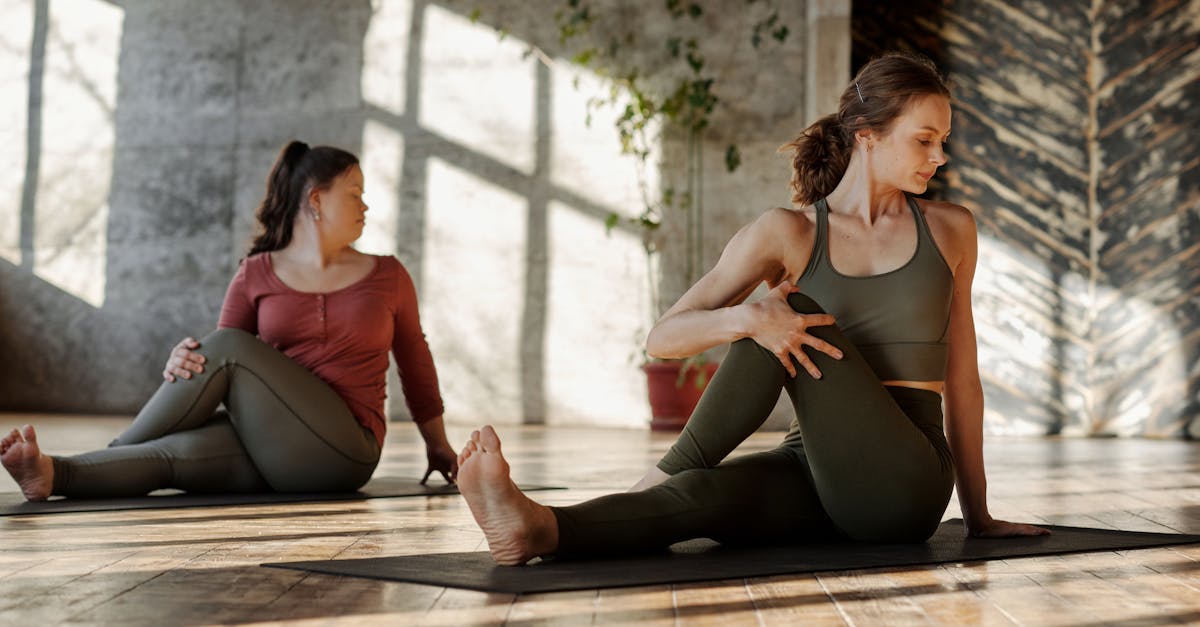|
In Short, overcoming dizziness is fundamentally linked to maintaining proper posture. This approach emphasizes the importance of alignment to alleviate uncomfortable sensations of spinning or unsteadiness. Proper positioning not only enhances balance but also significantly reduces dizziness symptoms, supporting better respiratory function and neck muscle relaxation. By integrating simple ergonomic adjustments in everyday activities, individuals can experience remarkable improvements in their overall well-being. This holistic method promotes a healthier lifestyle while addressing the root causes of dizzy spells through mindful movement and alignment awareness. |
Overcoming dizziness is closely linked to maintaining proper posture. The uncomfortable sensations often stem from misalignments caused by poor body positioning. By correcting alignment, such as avoiding forward head posture and adjusting sleeping or sitting positions, individuals can significantly reduce dizziness and enhance their overall well-being. Simple adjustments can alleviate strain on neck muscles, leading to better balance and posture. Cultivating awareness of one’s body alignment throughout daily activities is essential for mitigating discomfort and improving health.

Unlock Your Body’s Natural Balance at Pulse Align
At Pulse Align, we offer a unique and innovative approach designed to help clients restore their body’s natural balance and improve posture through gentle, imperceptible pulses. By integrating this gentle stimulation, we pave the way for improved muscle tone symmetry, contributing to a sense of well-being and reduced tension throughout the body.
Nurturing Natural Recalibration
Our focus is not on directly addressing discomforts, but rather on aiding the body in its ability to recalibrate itself naturally. Clients often find that this supportive method leads to significant enhancements in comfort and posture. This organic process allows individuals to experience a harmonious balance within their bodies without the need for invasive approaches.
A Personalized Approach to Wellness
At Pulse Align, we pride ourselves on our client-centric approach. Many of our clients have shared their positive experiences, noting remarkable improvements in their overall wellness journey. Testimonials highlight notable enhancements in neck and back tension, as well as a newfound sense of balance and comfort. With our tailored support, each individual’s path to well-being becomes uniquely personal.
Join Us on Your Wellness Journey
We invite you to explore our services further at the Pulse Align website. Discover more about our clinics located in cities like La Prairie, Mont-Royal, and Terrebonne, and see how we can help you and your family in your wellness journey. Please remember that our services are designed to complement your existing healthcare, ensuring a holistic approach to well-being. Book your consultation online today to embrace a safe, non-invasive method that the whole family can benefit from!
Experience the transformative power of rediscovering balance and functionality at Pulse Align.
Medical Disclaimer
The information and advice provided on this site do not replace the advice, diagnosis, or treatment of a healthcare professional. Clients should remain under the supervision of their healthcare team for any medical concern.
- Head Position: Keep your head aligned with your spine to minimize tension.
- Sitting Behavior: Maintain a straight back and avoid slouching.
- Sleeping Setup: Use a supportive pillow to align neck and spine.
- Movement Awareness: Incorporate regular breaks to stand and stretch.
- Ergonomic Furniture: Invest in chairs that support proper posture.
- Breathing Techniques: Practice deep breathing to alleviate tension.
- Mindfulness Practices: Stay conscious of body alignment throughout the day.
- Physical Activity: Engage in exercises that strengthen core and back muscles.

Dizziness is a common issue that can significantly affect daily life. A considerable yet frequently overlooked contributor to this sensation is poor posture. Understanding how body alignment influences balance and stability can lead to effective strategies for alleviating dizziness. This article provides practical tips on how to improve posture and positioning, ultimately promoting overall well-being.
The Connection Between Posture and Dizziness
It is essential to recognize that bad posture can lead to various health issues, including dizziness. When the body is misaligned, particularly in the head and neck areas, it can create unnecessary strain on muscles and joints. For instance, forward head posture often results in tight neck muscles and tension headaches, which can induce sensations of dizziness. By becoming aware of posture throughout daily activities, individuals can start to mitigate these discomforts.
Assess Your Daily Positions
Many people are unaware of their posture throughout the day. Regularly assessing your body alignment is crucial. Pay close attention to how you sit, stand, and sleep. Ideal positioning should promote a neutral spine and minimize strain on muscles and joints. By consciously adjusting these positions, such as keeping feet flat while sitting and avoiding slouching, individuals can significantly reduce discomfort.
Optimize Your Sleeping Position
Your sleep position has a considerable impact on your overall posture. If you frequently wake up feeling dizzy, it may be time to evaluate how you sleep. Opt for a pillow that provides proper neck support, keeping your head aligned with your spine. When sleeping on your side, ensure that your pillow adequately supports your neck without bending it excessively. A well-aligned position during sleep can help maintain spinal health and lower the risk of waking with discomfort.
Improving Sitting Habits
Sitting for prolonged periods can exacerbate poor posture. To combat this issue, maintain a straight back and ensure that your shoulders are relaxed and aligned with your hips. Use ergonomic furniture that supports proper alignment. For instance, adjust your chair height to keep feet flat on the floor and knees at a 90-degree angle. Remember to take breaks to stretch and reset your positioning—incorporating regular movement into your routine can stimulate blood flow and reduce muscle fatigue.
Mindfulness in Movement
Being mindful of how you move is crucial to maintaining good posture. Whether walking, standing, or engaging in physical activities, remember to keep a straight back and avoid leaning forward, particularly when using devices. Practicing stretches that target the neck and back can help alleviate tension and promote flexibility. Furthermore, engaging in mindfulness techniques, such as meditation, can enhance awareness of body alignment and encourage overall comfort.
Creating an Ergonomic Environment
Adjusting your workspace is another vital aspect of maintaining proper posture. Incorporate ergonomic elements to reduce strain during daily activities. Position screens at eye level to prevent neck strain, and utilize chairs that provide ample support. Designate an area for stretching during breaks to further promote alignment throughout the day. Additionally, keeping the workspace well-lit can minimize strain while reading or working on electronic devices.
Combining Lifestyle Choices for Better Health
Dizziness often intertwines with lifestyle factors such as stress and nutrition. Being mindful of these aspects and incorporating wellness practices can enhance overall health. Staying hydrated and consuming a balanced diet supports neuromuscular health and helps stabilize bodily systems. Embracing a holistic approach that addresses both posture and lifestyle can lead to substantial benefits in reducing dizziness and improving quality of life.
| Postural Issue | Wellness and Positioning Tips |
|---|---|
| Forward Head Posture | Keep your chin tucked and shoulders relaxed to reduce tension on neck muscles. |
| Slouching While Sitting | Sit upright, using ergonomic furniture to promote natural alignment and reduce fatigue. |
| Poor Sleeping Position | Utilize supportive pillows that maintain neck and spine alignment for restful sleep. |
| Rounded Shoulders | Practice regular stretching exercises that strengthen the back and open the chest. |
| Prolonged Sitting | Incorporate regular breaks for movement and stretching to stimulate blood flow. |
| Incorrect Head Positioning | Align your head with your body when using screens, avoiding forward bending. |
| Tension in Neck and Shoulders | Engage in mindful breathing practices to enhance relaxation and alleviate stress. |
| Lack of Core Support | Strengthen core muscles through gentle exercises to stabilize and support your posture. |
| Incorrect Foot Positioning While Standing | Shift weight periodically between legs and use supportive footwear for balance. |
| Improper Device Usage | Hold devices at eye level to prevent neck strain and maintain healthy posture. |

Client Testimonials: The Journey to Wellness through Proper Posture
“I had been struggling with persistent dizziness, and it was affecting every aspect of my life. When I discovered Pulse Align, my entire perspective shifted. Their unique approach gently guided my body to recalibrate and restore balance without invasive methods. I felt improvements in my posture and overall comfort after just a few sessions.” — Marie from Mont-Royal
“Being a long-time resident of Terrebonne, I truly value the personalized care provided by Pulse Align. They helped me understand the direct correlation between my posture and the dizziness that had been plaguing me for years. Their techniques allowed my body to naturally adjust, leading to a noticeable reduction in my symptoms and an enriched sense of well-being.” — Jean from Terrebonne
“As someone living in Chicoutimi, I appreciate how Pulse Align’s methods integrate seamlessly with my existing healthcare routine. Rather than solely addressing the symptoms, their focus on improving posture and alignment has empowered me to take control of my health journey. I have experienced a natural improvement in my balance and overall functionality, making daily activities much more enjoyable.” — Isabelle from Chicoutimi
“Pulse Align has been a revelation for me in Sainte-Marie. Initially skeptical, I was soon astonished by how the body’s innate ability to recalibrate could yield remarkable results. The team really listened to my concerns and provided effective strategies that continued to enhance my well-being over time. I can now enjoy life without the constant interference of dizziness.” — Michel from Sainte-Marie
“Living in Châteauguay, I’ve had the privilege of experiencing the transformative effects of Pulse Align. Instead of traditional methods, their personalized care process helped me understand how I could alleviate dizziness by simply being mindful of my posture. It’s incredible how much better I feel now, all through gentle adjustments and supportive practices.” — Lucie from Châteauguay
Clients throughout areas like La Prairie, Deux-Montagnes, and Saint-Jérôme have also seen the benefits of Pulse Align’s unique, holistic wellness approach. The feedback is clear—patients highly regard the ability of Pulse Align to assist them along their wellness journeys, working side-by-side with healthcare teams to support their families every step of the way. For more information on local services, visit our Our Clinics page.
Dizziness is a common yet often overlooked health issue that can significantly impact an individual’s quality of life. With various potential causes, one of the most prevalent reasons for experiencing dizziness is poor posture. Misalignment of the body can lead to excessive strain on the neck and back, resulting in discomfort and a sensation of spinning. Ensuring proper positioning during daily activities is crucial for maintaining balance and overall well-being.
Dr. Sylvain Desforges is a recognized expert in the fields of osteopathy, naturopathy, and manual medicine. As the founding president of TAGMED clinics and the ACMA association, he has dedicated his career to healthcare innovation and chronic pain management. Through his extensive knowledge, Dr. Desforges emphasizes the importance of proper body alignment to prevent conditions like dizziness from arising.
One of Dr. Desforges’ primary goals is to provide evidence-based care that helps his patients attain and maintain optimal health. He integrates advanced technologies, including spinal decompression, laser treatments, and shockwave therapy, into his practice. These innovative methods are designed to alleviate pain and discomfort, allowing patients to improve their posture and overall function. Dr. Desforges understands that ensuring proper alignment is a foundational step in preventing dizziness.
Improper posture can occur in various settings, whether one is at work, at home, or during leisure activities. For instance, spending extended periods seated at a desk with poor ergonomic practices can lead to cervical misalignment. This, in turn, can result in tension headaches and dizziness due to the strain on neck muscles. Dr. Desforges advocates for regular posture checks and adjustments to promote better alignment, especially while working on computers or using mobile devices.
Another vital aspect of Dr. Desforges’ approach is education. He teaches his patients how specific adjustments to sleeping positions can impact overall body mechanics. For example, using a supportive pillow that maintains alignment while sleeping is crucial to prevent neck strain. Dr. Desforges also recommends practices like maintaining a neutral head position and avoiding forward head posture, which places undue stress on the spine.
Regular movement and stretching are essential strategies that Dr. Desforges encourages for enhancing body awareness and counteracting the effects of prolonged poor posture. Incorporating brief breaks for stretching during work or after long periods of sitting can stimulate blood flow and relieve muscle tension. These simple adjustments can significantly improve posture and subsequently reduce the occurrence of dizziness.
Additionally, Dr. Desforges fosters a holistic approach to wellness by considering emotional and nutritional factors that may contribute to dizziness. He emphasizes that managing stress and eating a balanced diet can enhance overall health and stability. Adequately supporting neuromuscular health through lifestyle choices is essential for those managing dizziness related to posture.
Dr. Desforges’ commitment to patient care is evident in his interactive approach, where he actively engages with patients to develop customized treatment plans tailored to their specific needs. His focus on restoring balance through proper positioning and posture adjustment is instrumental in improving the lives of his patients in areas like Montréal, Terrebonne, and Mont-Royal. His dedication to educating individuals on posture’s critical role in preventing dizziness continues to transform lives and empower clients on their journey to well-being.
Neurovertebral Decompression Technology by TAGMED
Mechanism of Action
The neurovertebral decompression technology employed by TAGMED operates by applying controlled and progressive traction forces to the spinal column. This innovative technique works to increase the space between vertebrae, effectively alleviating pressure on intervertebral discs and nerve roots. By relieving this pressure, it facilitates better fluid circulation in the affected region, which is crucial for nourishing spinal structures. As a result, this process minimizes inflammation and provides pain relief. The enhanced circulation also contributes to better overall spinal health, promoting the body’s natural healing mechanisms.
Specific Benefits
This non-invasive method is particularly effective for mitigating chronic pain and associated symptoms related to conditions like disc herniation, disc bulging, and moderate to severe spinal or foraminal stenosis. By reducing the pressure exerted on nervous structures, the neurovertebral decompression optimizes fluid circulation around the discs, leading to faster recovery rates and improved quality of life for a diverse range of patients. Clients often report significant reductions in pain levels, allowing them to engage more fully in their daily activities and enjoy a higher standard of living.
Comparison with Other Treatments
When comparing TAGMED’s neurovertebral decompression technology with other commonly employed therapeutic approaches—such as analgesics, corticosteroid injections, surgical options, or traditional physiotherapy—the unique advantages emerge. Unlike surgical interventions, which can pose considerable risks and require prolonged recovery times, this technique is non-invasive. Patients often experience reduced recovery times, decreasing their reliance on medications and minimizing the potential side effects associated with pharmacological treatments. Many find that through this gentle method, they can achieve substantial improvements in their condition without enduring invasive procedures.
Case Studies or Testimonials
Numerous patient testimonials highlight the effectiveness of TAGMED’s neurovertebral decompression. For instance, patients suffering from chronic pain due to issues like sciatica or spinal stenosis have reported lasting reductions in their pain levels after undergoing treatment. They express appreciation for the swift recovery and the ability to resume their daily activities more rapidly after sessions. These accounts not only underscore the significant improvements in pain management but also demonstrate a reduced reliance on pharmaceuticals, showcasing a shift toward a more sustainable and healthy approach to pain relief.
Overcoming dizziness is a journey that significantly hinges on the understanding and correction of posture. Poor posture can disrupt the delicate balance within the body, leading to a range of symptoms including dizziness and discomfort. By recognizing the interconnection between posture and vestibular health, individuals can take proactive steps to improve their positioning, ultimately enhancing their overall well-being.
Adopting proper posture requires mindfulness and consistent practice. Individuals should be encouraged to regularly assess their alignment throughout daily activities, whether sitting at a desk, lounging on a couch, or sleeping. Simple adjustments, such as keeping the shoulders back, aligning the head with the spine, and using supportive pillows, can make a remarkable difference in alleviating muscle strain and preventing the onset of dizziness.
Moreover, incorporating postural exercises into one’s routine can strengthen the core and improve overall body mechanics. Engaging in stretches and movements focused on enhancing flexibility can significantly reduce tension in the neck and shoulder areas, which are often responsible for tension headaches and dizziness. Regularly moving and incorporating breaks into long periods of activity can revitalize circulation and keep the muscles engaged, further promoting balanced alignment.
Lastly, awareness of emotional and nutritional factors plays a crucial role in managing dizziness related to posture. Stress management techniques, hydration, and a balanced diet contribute significantly to maintaining optimal neuromuscular health. By embracing a holistic approach that combines proper posture with lifestyle choices, individuals can mitigate dizziness while fostering a sense of stability and well-being in their daily lives.

Do you suffer from a chronic condition that responds little or not at all to conservative treatments?
In today’s fast-paced world, many individuals search for non-traditional solutions to achieve a sense of balance and well-being. At Pulse Align, we offer a non-invasive, innovative method that helps restore the body’s natural balance and posture through gentle, imperceptible pulses. This approach aims to promote overall well-being by assisting the body in recalibrating its muscle tone, which can naturally lead to a reduction in discomfort and tension.
Rather than concentrating on pain or specific conditions, Pulse Align focuses on aiding the body in recalibrating itself organically. Our gentle method encourages your body to establish muscle tone symmetry, resulting in remarkable improvements in your overall comfort and posture. This focus on natural recalibration fosters an environment where clients often experience an enhanced feeling of wellbeing.
At Pulse Align, we pride ourselves on delivering a personalized experience tailored to each client’s unique journey toward wellness. Countless testimonials highlight how individuals have discovered notable improvements in muscle tension, tension, and overall wellness after engaging with our services. These personal experiences reinforce the effectiveness of our holistic method and the relief clients find from their everyday discomforts.
We invite you to explore our Pulse Align website where you can learn more about our approach, find nearby locations in cities such as La Prairie, Mont-Royal, and Terrebonne, and book a consultation for yourself or your family. Remember, Pulse Align complements your existing healthcare services and works alongside your wellness journey, embracing a natural path to improved well-being.
The state-of-the-art technology utilized at Pulse Align fosters muscle tone symmetry, effectively easing discomfort and promoting balance without invasive measures. Our gentle, sophisticated, and family-friendly services are safe for individuals of all ages, including children and pregnant women. Visit our website to understand better how we can support you in achieving your health goals. To learn more about our services and book an appointment, visit our website: Pulse Align.
Frequently Asked Questions
Vértigo
¿Los vértigos son más comunes en personas mayores?
Sí, con la edad aumentan los trastornos del equilibrio, y el vértigo es una causa común de caídas.
La caféine aggrave-t-elle la maladie de Ménière ?
Réduire la caféine, le sel et l’alcool est souvent recommandé pour mieux gérer les symptômes de la maladie de Ménière.
Does anxiety worsen vertigo?
Yes, fear of vertigo can create a vicious cycle, increasing anxiety and instability.
Peut-on prévenir les vertiges ?
Éviter les changements brusques de position, maintenir une bonne hydratation, traiter les problèmes auditifs ou de la tension artérielle peut aider.
Une carence en vitamine B12 peut-elle causer des vertiges ?
Une carence sévère peut entraîner divers symptômes neurologiques, dont des étourdissements, mais c’est moins fréquent.
Les troubles de l’équilibre et les vertiges sont-ils liés ?
Oui, les vertiges sont l’une des principales causes de troubles de l’équilibre, mais pas la seule.
¿Las infecciones virales provocan vértigos?
Sí, la neuritis vestibular, a menudo de origen viral, causa vértigo agudo, náuseas y problemas de equilibrio.
¿Los problemas de presión arterial causan vértigo?
La hipotensión ortostática (bajada de presión al levantarse) puede provocar mareos. Problemas circulatorios cerebrales también pueden desencadenar vértigos.
Les vertiges peuvent-ils être liés à la pression artérielle ?
Une hypotension orthostatique (baisse de la pression en se levant) peut causer des étourdissements. Des problèmes circulatoires cérébraux peuvent aussi déclencher des vertiges.
¿Una carencia de vitamina B12 puede causar vértigo?
Una carencia grave puede generar síntomas neurológicos, incluyendo mareos, aunque es menos frecuente.




